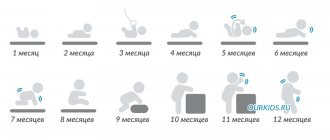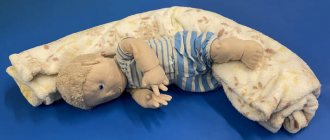Food
By the third week of a child’s life, the mother’s lactation is usually already established.
She learned to recognize and separate the baby's hungry cry from all other causes of his anxiety. And then suddenly the feeling comes that the baby does not have enough milk. He became restless at his chest and began to cry more often. If before he fell asleep on his chest or simply calmed down after eating, now it is not so easy to calm him down. Don't panic, this is your first lactation crisis. And most importantly, it won’t last long and it’s fixable. What to do if you have a lactation crisis?
1. Put the baby to the breast more often. The more often and more the baby sucks the breast, the more milk the mother will produce.
2. Get more rest. Peace for a nursing mother is very important. No “healthy teas for lactation” or similar preparations can replace rest. During this period, make it a rule: when the child sleeps, the mother sleeps.
3. Do not limit yourself in fluids and food (protein is especially important).
Your task is to survive this crisis and maintain breastfeeding.
The frequency of feeding the child during this period is approximately 10-12 times (sometimes more often).
The baby may spit up periodically. Half of children have at least 1 episode of regurgitation between birth and 3 months. If a child does not burp often and is gaining weight well, then there is nothing wrong with this (this phenomenon is called uncomplicated reflux).
Uncomplicated reflux does not require treatment or examination; it goes away on its own. This is a physiological feature of babies. They have a short esophagus and a very small stomach. By 10 months, more than half of children stop spitting up. By the age of 18 months in 80%, and by 2 years in 98% of children. If symptoms do not decrease or even increase by one and a half to two years, then the child should be shown to a pediatrician.
2 week old baby's stool
When a newborn is 2 weeks old, stools become less frequent and their consistency changes slightly. During this period, the baby can have bowel movements about four times a day. The color of the stool is yellow and the consistency is mushy.
Many mothers wonder: when a newborn is 2 weeks old, how much should he poop? There is no clear and precise answer to this. Every mother should know that problems with stool (as well as regurgitation and colic) will not go away until the child’s digestive system takes shape and gets used to it. Most often this happens after three months of age. If the baby is capricious a lot, pressing his legs towards his stomach, then this is a sign of colic. Most often they begin exactly when the newborn is 2 weeks old. The best remedies for them are stroking the tummy near the navel clockwise, dill water, a gas outlet tube and, undoubtedly, the love and care of the mother.
How much should a baby weigh at 1 month?
Normally, in the first month, a child should gain 600 grams and grow by an average of three centimeters. These indicators are very average and depend on many factors. Weight gain above average is also considered normal. It's worse when the newborn's weight gain is below average. In this case, there is a risk of malnutrition and you should definitely consult a pediatrician. Below is a table of the height and weight of a newborn when he reaches one month:
Baby weight chart at 1 month:
| Floor | Below average, kg | Average | Above average, kg |
| boy | 3,4 – 3,9 | 3,9 – 5,1 | 5,1 – 5,7 |
| girl | 3,2 – 3,6 | 3,6 – 4,8 | 4,8 – 5,4 |
Baby growth chart at 1 month:
| Floor | Below average, cm | Average | Above average, cm |
| boy | 51,1 – 52,7 | 52,7 – 56,7 | 56,7 – 58,4 |
| girl | 50,0 – 51,7 | 51,7 – 55,7 | 55,7 – 57,4 |
How newborns behave in the first month - baby’s reflexes
Reflexes are the body's response to various stimuli. In the first month of life, the child still has unconditioned reflexes that help him adapt to life outside the womb. Over time, reflexes are lost.
Parents should carefully observe every reflex of their child, because at the moment this is the only means of communication between the baby and this world.
How to find out if your child is in pain:
- If the child feels discomfort or is in pain, he will communicate this by screaming and intense movements of the limbs.
- Numerous studies have been able to prove that when pain occurs, a child bends his toes and straightens his thumbs.
- When colic begins, the baby will make active manipulations of the lower limbs.
- If suddenly the baby experiences discomfort associated with the ears, he will begin to vigorously turn his head.
If parents are attentive to their child and learn to understand his every move, this greatly simplifies life for the whole family.
How to test your child's reflexes
Preparation:
- The reflex test is carried out in conditions favorable for the newborn: the room should be warm and the child should lie on a flat surface.
- The baby should be fed, calm, in clean diapers, so that nothing distracts him.
- Mom's hands should be smooth and warm, and jewelry on the fingers and long nails should not interfere with the examination.
If all conditions are met, the assessment of reflexes will be adequate.
Checking your child's reflexes
Physically healthy one-month-old infants should have all the basic reflexes:
- Sucking. Touch your baby's mouth with a pacifier or the tip of a clean finger. The baby will try to grab the object and begin to make movements with its mouth that imitate sucking. This reflex is called the “sucking reflex”; it begins to appear almost immediately after birth. As soon as the baby is born, it is placed on the mother's breast and unconsciously the newborn begins to suckle.
- Prehensile. If you place your finger or a light rattle in a child’s palm, you can see how he firmly grasps and holds the object in his tiny palm for some time.
- Protective. Place your baby on his tummy and watch his head move. A healthy child will immediately turn his head to the side to breathe normally. Pediatricians call this reflex “protective.” If the baby has neurological disorders, he will not be able to turn his head to the side. The condition is dangerous because the baby can bury his nose in the surface on which he lies and suffocate.
- Crawling reflex. In the tummy time position, place your palms on your baby's feet. Feeling support, he will try to push off and make a movement, as if he wants to crawl.
- Automatic walking reflex. Holding the child by the armpits, place his legs on a flat, hard surface and tilt him forward slightly. The baby will begin to take steps independently with his feet.
- Search. If you stroke a baby on the cheek, he turns his head, this is how his instinct to search for food or “search reflex” is expressed.
- Babinski reflex. We easily run our finger along the outer edge of the foot, the baby’s toes spread out in different directions, and the feet turn.
- Mohr's reflex. Hearing a sudden loud sound, the child spreads and closes his arms and legs.
- Babkin reflex. With light pressure on the palm, the child opens his mouth and turns his head.
- Swimming. If you put the baby on his stomach, he begins to make swimming movements.
If you notice that some of your baby's reflexes are missing, consult a doctor immediately! This may indicate the presence of diseases of the nervous system.
Video by Dr. Komarovsky on this topic:
Main stages of development
While still in the maternity hospital, the child begins the stage of adaptation to changed living conditions. At this stage, all organ systems of the baby adapt to new conditions:
- The lungs begin to work, and the blood circulation is reorganized to function with the inclusion of the small circle.
- In the first days of life, a baby’s head is quite often elongated, which is associated with the flexibility of the skull bones and the baby’s passage through the birth canal. Its shape becomes correct by 2 weeks of age. In addition, many babies develop a birth tumor on their head, which disappears without a trace after 1-2 days.
- The skin immediately after childbirth has a reddish tint. In many children, from the third day it acquires a yellow tint - this is how physiological (non-dangerous) jaundice manifests itself, which normally disappears by 2 weeks of age.
- The nervous system is very sensitive and works actively. Various unconditioned reflexes appear, among which the main ones are searching and sucking.
- Thermoregulation is still imperfect, so the baby often experiences sudden changes in body temperature. The baby easily overheats and freezes quickly.
- A newborn has perfectly developed hearing, smell, taste and touch. At the same time, the child is weak, he sees everything fuzzy and blurry.
- After childbirth, many babies experience slight eye pain caused by weakness of the eye muscles. This condition goes away on its own over time.
- During the first day, urination occurs 4-6 times, and then the number of urinations per day reaches 15-20 times. In many children, on the first day, the urine acquires a reddish tint, which is normal and is associated with the low water content in colostrum.
- Various microorganisms enter the baby’s intestines, which were previously completely sterile. Meconium begins to be released from the intestines (the so-called dark feces that has accumulated in the baby’s digestive tract at the time of birth), and then the feces lighten and become more liquid.
Watch the episode of the famous children's doctor E. Komarovsky's program dedicated to newborn babies below:
At the next stage of development, which begins after discharge, parents have to deal with various difficulties, for example, colic, which often bothers the baby from 2-3 weeks of life.
By the end of the newborn stage, babies change noticeably - their facial features become clearer, postpartum swelling disappears, and their gaze focuses on faces and objects.
The baby's muscles become stronger, allowing him to briefly raise his head and move his limbs. In addition, the baby pleases loved ones with a “revival complex” - recognition of their faces, active movements and manifestation of positive emotions.
Children's sleep standards at different ages
From birth, children spend most of their time sleeping. Experts explain this by saying that the baby’s brain perceives a huge amount of information while awake, so he needs strength to process data and replenish his strength. The baby's unstable nervous system also needs rest. That is why doctors insist on approving a certain daily regimen. In this case, the baby gets used to sleeping at approximately the same time; a few daytime naps and a night nap are enough for him to recharge his body with energy and be ready for further exploration.
In a dream, a child not only rests and gains strength, but also calms the nervous system
Some parents do not attach much importance to rest, especially during the day. This is the wrong decision, because sleep is of great importance for a child:
- The baby gains strength for an active pastime. A sleep-deprived baby will not be able to engage in physical exercise or developmental activities;
- growth hormone is produced during sleep. This happens in the first two hours of rest. Doctors have proven that children who do not have good sleep are lagging behind in physical development and growth;
- The child’s nervous system needs rest. And if the baby does not sleep enough time, the body is under tension. This situation can be reflected by the manifestation of whims, hysterics and tears.
How much sleep should children sleep at different ages - table
| Child's age | Total hours of sleep | Number of hours of sleep at night | Number of hours of daytime sleep | How many times does a child sleep during the day? |
| 1 month | 15 — 18 | 8 — 10 | 6 — 9 | 4 or more |
| 2 months | 15 — 17 | 8 — 10 | 6 — 7 | 3 — 4 |
| 3 months | 14 — 16 | 9 — 11 | 5 | 3 — 4 |
| 4 - 5 months | 15 | 10 | 4 — 5 | 3 |
| 6 - 8 months | 14,5 | 11 | 3,5 | 2 — 3 |
| 9 – 12 months | 13,5 — 14 | 11 | 2 — 3,5 | 2 |
| 13 – 18 months | 13,5 | 11 | 2 — 2,5 | 1 — 2 |
| 1.5 - 2.5 years | 12,5 — 13 | 10,5 — 11 | 1,5 — 2,5 | 1 |
| 2.5 - 3 years | 12 | 10,5 | 1,5 | 1 |
| 4 years | 11,5 | 10 | 1,5 | 1 |
| 5 years | 11 | 10 | 1 | 1 |
If your newborn baby doesn't sleep well, should you worry?
Young parents often encounter sleep problems in newborns. If the child is healthy, then he sleeps continuously for 3-4 hours during the day, and wakes up at night to feed. But situations often arise when a mother rushes to consult a doctor, because... her baby does not sleep for 4–8 hours in a row, or falls asleep and wakes up after 5–10 minutes. A child can sleep a maximum of one hour without waking up, but this is not enough for a newborn baby.
Of course, first parents should rule out all sorts of domestic causes. The baby may be hungry, uncomfortable in a wet diaper or clothes, noise disturbs the baby, etc. But sleep improves as soon as parents eliminate the irritants. However, persistent sleep disturbances in an infant are a reason to consult a specialist, and urgently.
You should not delay visiting the doctor if your baby has persistent sleep disorders. Only a doctor can determine the cause and prescribe effective treatment
Approximate daily routine for a 1 month old baby
The main requirement that the regime must meet during the newborn period is the following: the child must grow up healthy and happy - which means he must receive so much milk and sleep so much per day in order to be able to develop normally.
The vital needs of a baby in the first month of life are minimal. A correctly selected daily routine by the hour will help you better distribute and carry out tasks related to caring for your baby:
- Feeding regimen - includes a minimum of 6 meals a day with an interval of no more than 3.5 hours. The night break can sometimes be up to 4-6 hours;
- Daytime sleep - a baby’s sleep during daylight hours should be continuous for 1.5-2 hours and 4-5 times a day;
- Night sleep - its total volume with breaks for feedings on demand can take on average 6-8 hours;
- Walks are recommended for newborn children both in the morning and in the evening. The length of time spent outdoors at this age depends on the time of year and weather conditions.
A table that can be taken as a basis for organizing the routine will help you create a baby’s daily routine in the first month.
| Time | Regime processes |
| 6.00 | First feeding. We try to swaddle the baby before feeding, then we feed, and then we put the baby to sleep. |
| 8.30 | Morning toilet for the baby: changing the diaper, washing, cleaning the nose from mucus and crusts. |
| 8.45 | Second feeding. After feeding, you need to hold the baby upright so that he burps out excess air. |
| 9.00 | Dream. |
| 12.00 | Third feeding, wakefulness, light tummy massage. |
| 12.30 | Walk outside: in the warm season - from 1 to 1.5 hours, in the cold - up to 1 hour (depending on the weather). |
| 15.00 | Fourth feeding. |
| 15.30 | Sleep on the street or in case of bad weather at home with an open window (the main condition for “walks” at home is to avoid a draft). |
| 17.00 | Wakefulness. |
| 18.00 | Fifth feeding, sleep. |
| 19.30 | Wakefulness. |
| 20.30 | Bathing. |
| 21.00-21.30 | Sixth feeding, sleep. |
| from 22.00 to 6.00 | Night feedings on demand |
Important! A properly formed daily routine is one of the important factors influencing the health of an infant. For a young infant, routine is the basis of education
Baby's vision at 2 weeks
Every mother wonders which sense organs a newborn (2 weeks) uses most? The development of vision and hearing during this period is in full swing. At two weeks of age, a newborn's vision becomes clearer but is still developing. The baby is able to see and focus on the face at a distance of 20 centimeters. The most attractive to him is the hair and mouth of his mother or father. The baby is still able to distinguish its mother mostly by smell. But he is already able to remember faces. Most of all, a baby at this age likes bright, moving objects, especially red. A child at this age does not have a coordinated gaze, there may be a slight squint, but there is nothing wrong with that.
To make your baby comfortable in the apartment:
- The room temperature should be 20–24 °C, humidity – 50–70%.
- Air the children's room for 10-15 minutes 4-5 times a day. The baby must be taken out of the room during this time. After ventilation, the temperature should drop by 2–3 °C.
- There should be no rugs or carpets in the room where the baby is. It is better to place books in cabinets with closing doors to prevent dust from settling on them.
- Do not place the crib near outlets or electrical appliances, including near a TV.
- There should be nothing hanging on the wall above the crib: remove paintings and decorations.
- Make sure the room is brightly lit: while awake, the child should clearly see the objects around him.
Two week old baby's hearing
All the baby’s senses, including hearing, are just developing at this stage. The sense of smell is most developed during this period, and hearing and vision are least developed. But, starting from the 2nd week of life, the child reacts to sound much more actively than before. When your baby is 2 weeks old, he hears sounds much more clearly and can focus his attention on them. Tips for mothers during the period when their child’s hearing is developing:
- you need to hum beautiful melodies and songs;
- talk to the baby;
- in front of a child, speak only in a calm tone, because during this period children are very sensitive to intonation, so in no case should you shout in front of them;
- protect the baby from sharp, loud sounds that frighten him;
- show the baby musical toys;
- try not to turn on the TV in the presence of the baby, it irritates the baby’s nervous system.
Feeding the baby
From the age of a week to a month, depending on the individual characteristics of the child, he needs to be fed approximately 6-7 times a day. The number of meals depends on what type of feeding the baby is on: breast or bottle-fed. But it is possible that the actual number of on-demand breastfeedings will exceed this figure.
A special table will help determine how much milk/formula a newborn baby should eat at one time and in general per day in accordance with the norm.
| Baby's age | Number of milk/formula consumed per day | Amount of milk/formula drunk per feeding |
| from birth to 5 days | 200-300 ml | 20-60 ml |
| 1 week of life | 400 ml | 50-80 ml |
| 2 weeks of life | 500 ml | 60-90 ml |
| 4 weeks of life | 600 ml | 100-110 ml |
Note! The exact amount of food intake is determined by the local pediatrician, based on the weight indicators and individual needs of the child. Avoid overfeeding your baby
Drinking a large amount of liquid can cause:
Avoid overfeeding your baby. Drinking a large amount of liquid can cause:
- digestive problems;
- incomplete digestion of milk/formula;
- constipation;
- frequent regurgitation of food;
- colic, etc.
It will be easier to organize your baby’s nutrition by the hour if you distribute meals evenly throughout the current day.
It is important for parents to know that formula-fed children eat less formula than their peers drink breast milk. To satisfy hunger, the baby will need less time on formula, but the break with this type of feeding should be longer
Feeding regimen for a one-month-old newborn baby from Doctor Komarovsky (video):
Nutritional Features
It is best if at two months the baby receives all the necessary components through mother’s milk. Artificial feeding should only be used as a last resort. A woman should rest more and eat right. Thanks to this, it is possible to provide the baby with milk with a complete set of nutrients.
During the two-week period, meals are provided quite often. Pediatricians advise feeding the baby on demand.
The development of a newborn will be normal if he is fed according to a mixed diet. To do this, you need to take a break of three hours. In rare cases, minor deviations from the schedule are allowed. Their period should not exceed half an hour. If the baby is already 10 days old, then he should receive one fifth of his own weight. If a woman doubts the correctness of the chosen feeding option, then she is recommended to take measurements for one meal. Thanks to this, you will be able to get your daily requirement.
In order for a child to gain weight, parents must adhere to the following rules:
- It is advisable to use a hydrolyzed mixture if the baby has previously been diagnosed with an allergy to milk or other food products.
- If the child often spits up, then it is advisable to give him a mixture with additional starch or gum. Eating foods with probiotics helps quickly and effectively get rid of colic.
- In medical practice, cases of lactase deficiency are becoming increasingly common. Children do not have the enzymes to digest milk sugar. In this case, baby food manufacturers suggest using a special type of artificial formula.
The second week is very important for the growth and development of the baby. If there is a need to use artificial nutrition, only a doctor can help you choose the right one. Only warm water can be used to heat food. You should give up the usual microwave. It negatively affects the structure of the product and can lead to serious complications.
If mommy manages to establish the feeding process correctly, then within 14 days the baby should gain weight. Evacuations should look like mush without additional impurities. A dirty diaper will be found three to six times a day.
Do I need to wake up the baby to feed and how to do it?
The baby is sleeping and you don’t want to disturb him, but after 3-4 hours of daytime rest he needs to be fed so that dehydration does not occur. At night, you need to wake up the baby after 5-6 hours. Perhaps the baby is a little fussy, but after feeding he will quickly calm down, relieve himself and fall asleep again.
You need to wake up your child during the nap period so that he does not get scared. It's easy to recognize:
- the eyelids tremble and are slightly raised, the eyeballs are in motion;
- limbs twitch;
- if you gently touch the baby’s face, his sucking reflex is triggered;
- facial expressions appear on the face.
Advice:
- Before waking up the baby, you need to curtain the windows or turn off the main lighting so that it is twilight in the room. Bright light acts as a sleeping pill on a newborn and has a bad effect on the retina of the eye;
- Before feeding, the baby should be unswaddled. Otherwise, stuffiness may provoke a refusal to eat.
Baby's behavior in the first month after birth
The child spends most of the first month of life in sleep, which is so necessary for his body to adapt to the changed conditions of existence.
In other words, the child grows while he sleeps. For the first 2-3 weeks, a newborn baby cries without tears. By crying, he communicates that something is wrong with him. Most likely he needs food or a diaper change. If nothing bothers the child, then during periods of wakefulness he will be calm. If the baby cries often (even if he is not hungry and dry), then something is bothering him. Watch the baby. And if you do not find an objective reason for crying, contact your pediatrician. Perhaps all is not well with the baby.
Due to strong muscle tension (tone) in the first month, the baby moves his arms and legs randomly. Such physical activity is of great importance for a young child. Thanks to this, the baby not only develops physically, but also intensively develops his brain, psyche and intellect. This is why you should not swaddle your baby tightly. Let him kick his legs freely and swing his arms. Stimulate his motor activity - do different exercises and massage with him. And then your child will be not only healthy, but also smart.
If a child lies motionless all the time, this indicates some kind of disorder in the baby’s nervous system. In this case, you need to urgently contact a neurologist.
This fragile infant dream
The sleep schedule of a one-month-old baby is also a purely individual matter. The daily sleep time of a one-month-old baby is an approximate value. Normally, newborns can sleep 18 to 20 hours a day. But this is relative. One baby needs 17 hours, another needs 22. This is natural: children are living beings, not robots. Read more in the article How much should a baby sleep at 1 month?>>>
True, you should know that a 1 month old baby sleeps with the breast in his mouth 98% of the time. Be prepared for this.
The sleep of a 1-month-old baby is influenced primarily by the state after birth and the conditions that surround the baby after.
All this is reflected in the regulatory properties of the nervous system, on which the duration and quality of rest actually depends. One month-old baby sleeps peacefully between feedings, the other tosses and turns in his sleep, often wakes up and looks for the breast.
In general, at 1 month you need to build the rhythm of your baby's day, focusing on his waking time. At 10 days, it won’t be longer than 20 minutes, which means all you have time to do is change the diaper, wash your butt, change your clothes, coo a little and it’s time to sleep.
Towards the end of the first month, the child begins to stay awake for up to 40 minutes. After this time, your task is to help him relax and put the baby to sleep.
A one-month-old baby's daytime sleep can take place either in a separate crib or under the mother's side, and often the baby simply falls asleep on the chest and sleeps while feeding. Without considering this as rest, many mothers begin to think that the baby sleeps little, although this is not the case. Or that he doesn’t have enough milk, which is also not true.
A one-month-old baby's sleep at night usually consists of longer intervals than during the day. But, again, it all depends on the specific situation. Some children wake up to eat 2-3 times a night, others need it much more often. All these are the individual needs of a particular baby, which during the first month cannot and should not be driven into the framework of a “strict regime”.
Daily regime
A baby's development at 2 weeks occurs largely during sleep. Sleep takes up most of the day. It is considered normal if a baby sleeps from 15 to 20 hours a day. If sleep is less than 15 hours, and the baby is capricious and crying, this is a reason to consult a doctor.
Feeding takes place every 3 hours. Periods of wakefulness are already increasing and range from 20 to 30 minutes. With a 2 week old baby, mommy can already go for walks.
In order for the baby to sleep well, the room must be ventilated and kept clean. You cannot play loud music or make noise while your baby is sleeping: the baby will sleep restlessly in bright light.
Hygienic procedures are carried out taking into account the physiological characteristics of boys and girls.
Physiological and psychological development
The baby is growing and gaining weight, every day he becomes more active. At 4 months, boys weigh 6.2-7.8 kg with a height of 61.8-66.0 cm, the corresponding figures for girls are: 5.6-7.2 kg and 59.9-64.3 cm.
The “fastest” children are already trying to move independently: they try to crawl, lying on their tummy and helping themselves with their hands, or take a frog pose and push off with their legs. It happens that it is easier for babies to move backwards, and they do not immediately learn to crawl forward. Many children can roll over from their tummy to their back or even from their back to their tummy.
The child actively uses his hands to explore the world around him. He reaches for objects and grabs them with his palm. His fingers are still not dexterous enough.
If previously the child clearly saw objects that were at a distance of up to 30-40 cm, now he can focus his vision depending on whether the interesting object is closer or further away. The baby distinguishes colors better and can even see differences in different shades of the same color. He reacts joyfully to the appearance of new objects and a change of scenery.
At this age, the child distinguishes all basic sounds and reproduces some of them. He can imitate the facial expressions of mom and dad and repeat some syllables, for example, “ba-ba.” He likes even more to reproduce coughs, mutterings, and shrill screams, and he repeats them over and over again, now lowering and now raising his voice. Now, while awake, the child no longer requires your constant presence nearby, giving the mother a break for a few minutes.
He may play with his arms and legs for a while, repeating the same movements several times. This is completely natural, because at this age children usually repeat all actions many times in order to understand them before starting to learn a new skill. For example, a baby can say the syllable “da-da-da-da” for several days, without trying to diversify its vocabulary, and then also repeat “bu-bu-bu-bu” for a long time.
A mirror is a favorite pastime for children at this age. The baby can admire his reflection for a long time, smile at it, and study hand movements. Faces of any kind and shape fascinate children: they look with interest at people, dolls and even scary, at first glance, ritual masks, but the child’s greatest interest is caused by mom and dad. When communicating with parents, the baby pulls their hair, strokes their head, feels their forehead, nose, and chin.
The baby develops a sense of humor: he can laugh merrily if dad makes funny faces or makes funny sounds, imitating animals. For young children, fun and fear are closely linked. Laughter provides an outlet for growing tension, but excessive excitement can frighten the baby and cause tears. Just now the child burst into laughter when he was tickled and lifted up, and now he is crying loudly. During noisy games, it is necessary to carefully monitor the baby so as not to overexcite him and promptly offer the baby a calmer activity.
Caring for a one-month-old baby: daily routine, gymnastics, massage
A routine of alternating sleep, wakefulness and feeding will be established in a healthy child independently in accordance with his physiology. Don't worry if your baby doesn't fall asleep on time, as it might seem. The biorhythms of newborn children are adjusted, so the mother can only try to understand and maintain the rhythm of her child. Having studied the behavior of the child in a state of rest and anxiety, it becomes easy for parents to recognize the “requirements” of their baby.
Feeding
During the first month of life, a healthy child eats at least 8-9 times a day, drinking 60 ml of milk for each meal. Frequently putting a baby to the breast is the main way to stimulate lactation. Mothers who practice breastfeeding have 10–12 feedings per day. At the first sign of the baby's distress, the baby should be given the breast. This method is called feeding on demand, or, otherwise, “free feeding mode”.
Important! Children should be fed only breast milk per month, unless the milk is objectively insufficient, or the pediatrician has recommended supplementing the baby with formula. Also, the child should be offered warm boiled water with a temperature of up to 36 degrees, especially in the hot season
Dream
The child spends the first month of life sleeping most of the day - about 18-20 hours.
In infants during this period of life, there are five states in which the baby may be:
- deep sleep - the child is relaxed, eyes are closed, breathing slowly and evenly;
- shallow sleep - the child has uneven breathing, noticeably rapid, twitching of the arms and legs is observed, the movement of the eyeballs under the eyelids can be discerned;
- drowsy state - occurs most often while feeding a child or before falling asleep, characterized by half-closed eyelids;
- wakefulness – makes movements with the whole body, is active, wiggles its arms and legs;
- Crying indicates discomfort that the baby feels. May be caused by hunger, fright, or a wet diaper.
Bathing and hygiene procedures
Hygienic procedures for a child per month are carried out daily and include:
- washing the face, eyes, neck;
- washing, changing a diaper;
- care for eyes, nose, ears;
- daily treatment of the umbilical wound;
- combing and removing crusts on the head;
- trimming nails.
Parents choose the baby’s bathing regimen independently, since the condition of the baby’s skin does not require a full daily bath in the bath. It is necessary to carry out daily body rubdowns. In the full sense, it is enough to bathe only 2-3 times a week. To soften the water, you can add herbal decoctions - chamomile and string. The use of solid/liquid soap is also determined individually, based on the sensitivity of the baby's skin.
Walks
Walking is important for the health and full growth of the baby in the first month of life. A child takes his first breath of fresh air upon leaving the maternity hospital.
The duration and frequency of daily walks with parents in the first month depends entirely on the time of year and the temperature outside the window.
- The first walks with the baby take only 10-15 minutes, the subsequent duration of being outside gradually increases to half an hour.
- In the warm season, the duration of the walk can reach 1.5-2 hours.
- In the cold season, when the air temperature is below 10 degrees, as well as in the case of strong wind, rain, snowfall, it is not recommended to walk with a child during the first 2 months of life.
On a note! The system for regulating heat exchange in infants of this age is imperfect, so the issue of walking in the cold season must be approached with all seriousness. When there is bad weather outside, it makes sense to take your dressed baby out to the balcony for a few minutes to breathe clean air or let him sleep in a stroller with the window open.
Gymnastics and massage
From about the second or third week of the baby’s life, it is worth starting to give him air baths, as well as hardening and massage.
Gymnastics for a baby at 1 month of age (video instruction): These procedures can be successfully combined in one procedure. To begin with, you can leave the child for a couple of minutes in one light vest or undress and cover with a diaper. At the same moment, begin to do light, barely noticeable stroking with your hands all over the child’s body - arms, tummy, legs. Massage serves not only as a strengthening, but also as a developing, accessible means for the muscles of a one-month-old baby. In subsequent times, it is necessary to carry out the massage a little longer in time - 5-7 minutes. If the baby calmly tolerates your touch and does not show dissatisfaction, you can include massage in your daily restorative procedure.
PS Also read about the development of the baby in the subsequent months of life up to 1 year.
Child development 2nd week of life
A two-week-old baby is no longer the same baby you recently picked up from the hospital. And although you may not be able to see these differences visually, believe me, they are very significant.
Week 2. Physiology
The child has already adapted to the conditions of his life. By 2 weeks, he stops losing weight, gains back the weight he lost in the first week while he got used to the new way of eating, and even begins to gain weight. The baby has bowel movements about 3-4 times a day, all signs of physiological jaundice disappear. The umbilical wound should already have healed by this time.
At the age of 2 weeks, the child does not yet see clearly enough; he can distinguish “noticeable” parts of the face (eyebrows, lips, nose) at a distance of 20-25 cm. A two-week-old child already fixes his gaze on the eyes of the people around him.
You should not be afraid of slight squint in babies of this age, because the eye muscles have not yet become stronger and will be better able to maintain focus closer to a month. Before this period, the eyes may periodically squint. If you bring any object closer to the eyes, the child will blink quickly.
What can a two-week-old baby do?
The baby can, on a whim, recognize faces and their facial expressions, and even imitate them. You can approach the baby and make a face. After a while, the child will try to repeat your gestures. At this age, the baby can already hold your gaze for several seconds.
Bright objects that move already arouse interest in babies in the second week of life. You can observe this if you slowly move a rattle at a distance of 10 cm from the baby's eyes. You will notice that the baby is able to keep his eyes on the toy for a short period of time.
The child begins to perceive the world around him not only at the level of reflexes, but also with the help of his senses. So the baby calms down from the sound of his mother’s voice, which sings him a song, or from the loud rattling of a rattle - he receives new sensations for himself and concentrates on them. The organ of balance manifests its action when we rock the baby or change the position of his body. The child gains a certain experience through his sensations. It's time to start training the vestibular system, because if the child constantly lies motionless in the crib, this will slow down his development.
Baby's nutrition and sleep in the second week
The child sucks the breast or bottle with concentration and rhythm, and eats more food (breast milk or formula). Breaks between meals should be 1-1.5 hours during the day and 3-4 hours at night.
The child is already capable of some activity in the interval between sleep and eating. He is actively exploring the world around him, but the still fragile nervous system quickly gets tired of an overabundance of new sensations, so the baby may fall asleep from fatigue or be irritated. Babies two weeks old benefit from short walks in the fresh air, which promote better sleep.
Intestinal colic is often the cause of crying and restlessness in a two-week-old baby.
Important! Intestinal colic is not a disease. This is a natural process of adaptation of the digestive system to the environment and nutrition. During this period, intestinal microflora is formed, and gas bubbles accumulated in the intestines cause discomfort in the baby.
The unpreparedness of the gastrointestinal tract for active pickling of food, according to doctors, leads to painful sensations. You can observe how the child experiences unpleasant feelings, trying to get rid of gas, bending his legs and crying. The tummy is swollen.
Various folk remedies (dill water, for example) or modern special medications will help relieve colic in infants. You can calm your baby by rocking him to sleep or give him a massage by stroking the tummy around the navel clockwise.
Intestinal colic can begin to bother a child at the age of 2-4 weeks, but by 4 months it usually ends. Your pediatrician will certainly suggest methods of dealing with colic that will help your child get rid of painful sensations.
What should a 1 month old baby be able to do?
A newborn should be able to clench his fingers and bend his legs. Mom needs to gently unclench her fingers and legs during the first weeks. Your baby's legs will naturally curl into the fetal position they were in before birth. The first few weeks will pass before the baby learns to straighten up from the fetal position. It will take even more time to pronounce peculiar sounds called “baby speech.” This will be a loud activity in the initial stages. In addition to crying in uncomfortable situations, a month-old baby begins to make a whole variety of sounds.
By the beginning of the second month, the child can:
- squeak,
- squeal
- grunt,
- sigh,
- groan,
- hiccup,
- sneeze.
The baby mainly produces sound in response to external and internal stimuli.
Revitalization complex
An important milestone in growing up. More often it appears closer to a month or even a little later. But some newborns can “boast” of it already at the age of just over two weeks. The “revitalization complex” is manifested by a smile to the mother, joyful movements of the arms and legs to address the baby, and a general positive mood. The appearance of a “revival complex” indicates the successful completion of the period of postpartum adaptation of the baby and the active establishment of connections with the outside world.
Movements
- He no longer just grabs and squeezes your fingers, he makes attempts to pull himself up, to rise, holding on to his fingers. This is the unconditioned grasping reflex.
- His movements turn from chaotic twitching into more orderly ones.
- Try stroking your newborn's cheek. He will immediately turn his head in this direction, as he takes your hand on his chest.
- You increasingly place your newborn on his tummy, and he tries to raise his head. With his sparkling eyes, he looks around everything around for 10-15 seconds, then his strength ends and his head drops. And when you place him in a semi-lying position, he examines his possessions, turning his head in all directions.
- If you move the rattle slowly in front of his face from right to left or back, your newborn will follow it, although the color still doesn't tell him much.
- And if you put him barefoot on a table or on the floor, support him by the arms and lift him a little, the baby begins to move his legs, as if he were actually walking.
What can a 2 week old baby do?
It turns out that there is a lot! For example, to make it easier for a baby to start his life’s journey, nature endowed him with innate reflexes.
The first cry, the first sneeze, sucking on the mother's breast - the baby does all this reflexively.
The presence and severity of unconditioned congenital reflexes is the most important indicator of a baby’s health.
With the sucking reflex, everything is probably clear. But there is also, for example, a search engine! Try to touch the corner of the baby’s mouth with your finger: and you will see how he actively begins to look for his mother’s breast. There are other important reflexes of a newborn, aimed at the baby’s survival in the external environment. For example, a protective reflex. Put the baby on his tummy: and he will immediately “automatically” turn his head to the side. This way he can breathe freely. Whatever you put into your small palm, the baby clenches his fingers into a fist. This is how the grasping reflex works. Everything is clear here - it is vitally important for the baby to hold on to his mother more tightly.
Establishing a newborn baby's sleep schedule
Many couples, when becoming parents, make a promise to themselves to do everything right and take the best possible care of their child from birth. If you also intend to strive for this, then you need to think about establishing a sleep schedule for a newborn baby literally from the first days of his life.
- A huge number of mothers take their baby into the parental bed, but this decision has both advantages and disadvantages. Remember that it will be very difficult to wean your child from co-sleeping, so perhaps you should just move the child’s bed to the parents’ bedroom?
- When a child has difficulty falling asleep, parents often try to help him by rocking him to sleep, but pediatricians have different views on this process. When making a decision about rocking a child, weigh all the pros and cons.
- It is noteworthy that during the newborn period, a child practically does not need special conditions for sleep - just ensure his safety in bed by removing everything unnecessary from it, and he will be able to fall asleep on his own - from fatigue. And, of course, do not forget about control.
The main problem of modern parents, as a rule, is lack of sleep - despite the fact that the child sleeps a lot at first, parents have a lot to do: washing, cleaning, cooking, etc.
We should also not forget about the personal needs of each and the need to remain a couple - in this regard, the importance of working on establishing a sleep schedule for a newborn child cannot be overestimated. However, be patient - the situation will not stabilize as quickly as we would like











